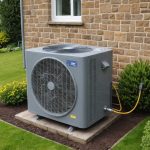Understanding Your Smart Thermostat
Exploring your smart thermostat‘s functionalities is pivotal to maximising both comfort and savings. At its core, a smart thermostat is designed to adjust your home’s heating and cooling systems automatically using intelligent algorithms, potentially leading to substantial energy efficiency improvements. This modern device learns your schedule and preferences, allowing it to regulate temperatures appropriately without constant user input.
Thermostat features you should consider include programmable settings, remote control via smartphone apps, and integration with existing smart home systems. These features enhance convenience by offering seamless control over your environment and ensuring your home is conditioned efficiently.
A lire également : Key Factors to Consider for Installing a Biomass Boiler in Rural UK Settings
Adjusting the user settings is instrumental in boosting energy savings. By setting schedules that align with your daily routines and using features like geofencing—where the thermostat detects when you’re near home—your smart thermostat can optimise energy usage effectively.
For achieving these benefits, it’s essential to understand your thermostat’s interface and options thoroughly. Familiarising yourself with its functionalities empowers you and ensures that you’re using it to its full potential, ultimately leading to cost savings and a more comfortable home atmosphere.
Sujet a lire : Smart Strategies for Safely Managing and Disposing of Cooking Oil in Your UK Kitchen
Optimal Thermostat Settings for Energy Savings
Understanding thermostat settings can significantly impact your energy savings. By maintaining the ideal temperature for each season, you can efficiently manage your home’s climate while reducing costs.
Typically, during the winter months, it’s best to keep your thermostat at around 18°C, ensuring warmth without excessive energy use. As for the summer heat, a setting of 26°C helps balance comfort with savings, avoiding overuse of air conditioning.
Programming your thermostat is crucial to maximise efficiency. Modern thermostats often come with options to schedule temperature adjustments. For instance, lowering the temperature during nighttime or when you are at work can lead to desirable energy savings. Simple, planned adjustments can reduce the strain on your heating and cooling systems, extending their lifespan.
Consistent temperature management translates into noticeable benefits on your energy bills. By maintaining a stable environment, your system operates smoothly, using less energy and maintaining comfort. Moreover, sudden temperature changes require more energy, increasing utility costs. Thus, a strategic approach to thermostat use not only ensures a comfortable atmosphere but also contributes to long-term financial benefits.
Seasonal Programming Techniques
Achieving optimal efficiency in thermostat programming requires understanding seasonal demands. Adjustments can ensure home heating and cooling are both effective and economical.
Winter Settings
During winter, it is crucial to set thermostats to energy-efficient temperatures. Generally, a cozy 68°F during the day when home, and lowering it by 7-10°F at night or when away, can save you up to 10% on heating bills. Proper seasonal adjustments can ease your energy expenditures without sacrificing comfort. Thermostat features like smart scheduling can automate changes, ensuring a warm welcome when returning home.
Summer Settings
In summer, energy savings come from cooling strategies. The target home cooling temperature should be around 78°F when at home. Thermostats with features like fan modes help circulate air, reducing the need to lower the temperature significantly. These seasonal adjustments optimize cooling without overwhelming energy costs.
Transitional Seasons
Transitional seasons require a balancing act. During spring and autumn, managing the thermostat programming means being adaptable. Embrace the mild weather by relying on natural ventilation when possible. Smart thermostats often provide adaptive settings for fluctuating conditions, allowing seamless transitions between heating and cooling without constant manual intervention.
Financial Benefits of Smart Thermostat Use
Smart thermostats, with their cost-saving potential, offer measurable financial advantages. Estimates suggest that homeowners may see up to a 10-15% reduction on heating and cooling utility bills. The key driver of these savings lies in their programmable features. By allowing users to set precise temperature schedules, smart thermostats avoid unnecessary energy consumption, directly impacting monthly costs.
Here’s a look at how these devices contribute to reduced expenses:
- Efficient scheduling: With the ability to customize heating/cooling patterns, users optimize energy use without sacrificing comfort.
- Remote access: Control from mobile apps or web portals means instant adjustments, catering to fluctuating climates or routines.
- Learning capabilities: Over time, models adapt to user behaviour, automatically adjusting settings for optimal comfort and efficiency.
The long-term financial benefits extend beyond mere monthly savings. Consider the return on investment (ROI); users often recover the initial smart thermostat cost within two years through reduced utility bills. Additionally, over the lifespan of the device, homeowners can accrue hundreds, potentially thousands, in saved costs. Embracing smart thermostats isn’t just a modern convenience—it’s a financially sound decision.
Common Mistakes to Avoid
In managing smart thermostats, homeowners often encounter challenges that lead to unnecessary energy wastage. One frequent issue is thermostat errors due to improper settings. Erroneous programming can override energy-efficient plans and unexpectedly increase costs. For instance, setting the temperature too high or leaving the system on when no one is home can drastically inflate electricity usage, counteracting any intended savings.
Another typical oversight is neglecting regular maintenance of the thermostat. While smart devices offer convenience, they require periodic check-ups to ensure optimal functionality. Dust accumulation or outdated software can compromise performance, leading to inefficiencies.
Avoiding these pitfalls involves setting the thermostat according to recommended schedules and seasonal temperatures. For example, lowering the heat at night or when away can yield significant savings. And importantly, staying updated with software and controller diagnostics can prevent energy wastage.
Smart thermostats are valuable but can inadvertently drive up expenses if not managed mindfully. By understanding these common mistakes and implementing homeowner tips, users can achieve efficient energy management and cost savings while enjoying the comfort and ease these devices offer.
UK-Specific Regulations and Incentives
Navigating the landscape of energy regulations in the UK can be complex yet crucial for homeowners seeking efficiency. The Energy Regulations UK mandate that properties meet certain efficiency standards, impacting both residential and commercial sectors. Understanding these regulations not only aids in compliance but also paves the way for eco-friendly solutions.
When it comes to Energy Saving Incentives, the UK government provides various options to encourage eco-conscious upgrades. For example, homeowners can benefit from grants or financial aids for smart thermostat installation, among other energy-efficient improvements. This proactive approach supports both environmental goals and financial savings, presenting a win-win situation for residents aiming to enhance their home’s efficiency.
New regulations can significantly influence energy consumption strategies. By adopting Eco-Friendly Solutions, individuals can align with governmental guidelines while reducing their carbon footprint. Implementing smart technologies and improving insulation are practical measures that coincide with these new standards.
For individuals seeking to navigate this evolving landscape, understanding the interplay between regulations and available incentives is key. Empowered with this knowledge, homeowners can make informed decisions that benefit both their wallets and the environment, transforming compliance into an opportunity for innovation and sustainability.











